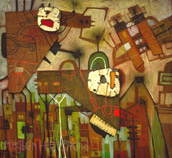The Good Book!
Amatoritsero Ede
On a homeward trip from the annual African Literature Conference in Tucson, Arizona, I made a bus-detour into Phoenix, had a two-day layover due to delays and later boarded a flight from there for Ottawa via Chicago. On the last leg of the trip I cast around for something to read and finding none in the pouch on the back of the seat in front of me, asked the flight attendant if they might, perhaps, have some newspapers on board. No! But there were some magazines. This is how I first came to read about the 21st century wonder named ‘the Espresso Book Machine’ between the pages of the Economist magazine.
As can be easily guessed this particular espresso does not refer to the ubiquitous and famous pressurised coffee brewer or its brew but to a ‘book machine’, literally, which mimics the coffee kit’s speed of execution as suggested in ‘espresso.’ The idea of near-instant availability is emphasised by the description ‘machine’ – in an age where mechanical automation coupled with digital technology has normalised quick-paced modern convenience. It is probably the normalisation of high technology in contemporary culture which has downplayed the revolutionary nature of the EBM invention. It appears to be just another ‘gimmick’ in a gimmick-suffused world:
The Espresso Book Machine – meaning “fast,” not coffee – can churn out a 300-page paperback on demand, complete with color cover, in just 3 min. The $50,000 machine could transform libraries into minibookstores, making hard-to-find titles as accessible as cappuccinos. (Time Magazine, Nov 1 2007)
Such a contraption presents a myriad of possibilities for traditional brick-and-mortar publishing as well as for publish on demand concerns and bookstores. As a matter of fact, a handful of libraries, commercial, university and publisher’s bookstores (including Alberta, McMaster and McGill universities, Blackwell publisher and New York Public Library) have installed the EBM. The immediate practical use of the EBM is towards the ‘printing and binding’ of books that are rare or out-of-print. All that is necessary is for the text to be available in the EBM database in PDF; the machine then prints it in black and white library quality with a four-colour paperback cover. The book pops out fresh-baked, as it were, and hot or warm like bread from the delivery chute under minutes. What are the ramifications of this marriage of computer technology, digitisation and the mechanical for the survival of the book as a cultural object or for the discipline of Book History?
First a digression – the EBM, as unprecedented as it is, should not be such a huge surprise to the publishing world. Its fate is firmly linked to Johannes Gutenberg’s 15th century invention of the printing press, which revolutionalised textual production, moved Europe from a manuscript into a book culture and facilitated the speedy transmission of texts and the dissemination of knowledge in science and the arts in the Western hemisphere. Of course the matter of the West’s indebtedness to preceding cultures in terms of printing and knowledge production has always been occluded, but this is neither here nor there. Suffice it to say that the revolution began by Gutenberg is only being fine-tuned more than five hundred years later. The same principle of a mass production of text is involved. The difference in the EBM instance is that proliferation is raised to the nth power; it is the arithmetic permutation of a Gutenberg phenomenon separated from us by many centuries. The EBM is at the intersection of more than five hundred years of, first, analog and, latterly, digital technological advances. The complex interweaving and mutual dependence of these technologies will ensure the perseverance of the book – especially when such a dynamic is accompanied and facilitated by such uncanny ease and unearthly simplification as the EBM demonstrates. It is reasonable to project that the EBM has recalibrated the scales and elongated the endangered life of the book.
An ageless book is now very possible even in spite of the threats from the Internet and related alternative ways of text generation, reading and interaction with the text – such as hypertexts, the kindle and e-books. Nevertheless the EBM presents new challenges or perspectives for book history as discipline.
From all accounts the EBM’s data bank consists of texts that are ‘orphaned’, meaning such material have passed into the public domain, are not copyrighted, are out of print and so on. Nevertheless serious copyright infringements can occur by accident or design. The threat of book piracy and the stealing of intellectual property are very possible and real. There are other book historical questions which might immediately interest the expert such as how the EBM will affect author-publisher relationships, and the book production process, its attendant questions of authorship, authorial intention and authority – texts in a data bank are probably amenable to manipulation, corruption, viral attacks and so on. This is closely tied to the question of online security generally, prone as the Internet is to interference and in spite of the illusion of textual safety.
Self-publishing will certainly proliferate and the mediation between author and book through the editor might be short-circuited and contribute to the corruption of an otherwise ‘original’ text. Peer-review processes could be undermined, leading to a general lowering of literary and editorial quality. Such problems would be complicated by vanity publishing, which, like self-publishing, has always had a tendency to discard editorial felicities. Certainly there are other less immediate complexities, which will unfold with time.
In all of this however the existence of the EMB is, of course, worthy of celebration and has more positive than negative connotations – one of which is the perseverance of the good book. The religious allusion in that last sentence brings to mind the near impossibility of a religious text being read interactively to deliver a sermon, or for reading during private meditation. The processes of reading, sermonising, and indoctrination – for example in the Islamic tradition – is a ritual that insists on the physical presence of the ‘magical’ text. But perhaps technology will catch up with or become incorporated as stages in those rituals. All in all what the EBM does is to futuristically confirm the book as an object of fetish per excellence.



